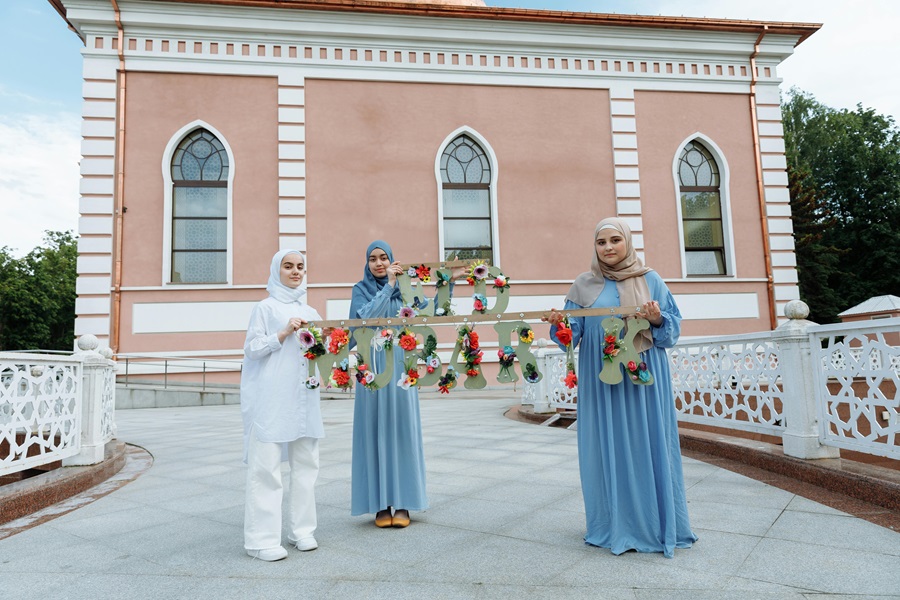
Published :
Updated :

Did you know there are synonyms for Eid? In Turkey, people call it "Bayram"; in Indonesia, it's "Lebaran." In Malaysia, you might hear "Hari Raya Puasa", which translates to the grand day of rejoicing after fasting and in some parts of Africa, people call this occasion "Korite" or "Sallah." Pretty interesting, no? But have you noticed how people celebrate Eid? It can be quite different depending on where they live. Each country adds a unique touch of their culture to this festival, from Africa to the Middle East to Asia. Let's tour the world and learn how Eid is celebrated across borders.
The Middle East, or Saudi Arabia more specifically, is where Islam first began. They address Eid as Eid al-Fitr or Eid al-Adha. Their families wear their finest clothes called "Thobes" and embroidered, flowy "Abayas" for women. The celebration starts with special prayers at mosques. Right after prayers, they enjoy a feast of "Kabsa" (spice-infused rice with meat dish) and "Luqaimat" (sweet dumplings) and dates. Camel races and fireworks add extra sparkle to this celebration.
Now, it's time for Egypt, where children run around the neighbourhood with colourful lanterns called "famous" and sing their special Eid song (just like our "Romjaner oi roar she she"). Their day starts with prayers and then goes straight to the Nile River for boat rides. Families share tasty nut-filled sugar-dusted butter cookies named "Kahk."
Now, let's hop over to Turkey, where Eid is called "Ramazan Bayrami" (Eid al-Fitr) and "Kurban Bayrami" (Eid al-Adha). The Sugar Fest has a separate fanbase. Children go door to door, greet elders, and receive chocolates, baklava, and other Turkish delights in return. People also visit cemeteries to honour their loved ones. Eidie is a cherished tradition there.
Next stop, Asia! The world's largest Muslim country, Indonesia, celebrates Lebaran in a grandiose manner. It's also the most significant travel event of the year. Why? Loads and loads of people travel back to their hometowns to be with their families and share happiness, a tradition widely known as Mudik (one of the most significant temporary migrations simultaneously). They seek forgiveness from their ancestors as a part of the Eid tradition named "Halal Bihalal". Unique dishes like "Ketupat" (rice cakes wrapped in coconut leaves) and "Rendang" (spicy beef stew) are prepared.
Zooming over Pakistan, given the huge craze over Agha Noor, Sada Bahar, Maria B, Sana Safeenaz, and Bareez, it's quite evident Pak women wear vibrant salwar kameez, and men are seen in Kurta pyjamas. Chaand Raat is all about shopping, applying henna, and glass Bengals. After the Eid namaz, they prepare a feast of Biriyani (spice-infused meat and rice) and "Sheer Khurma" (milky pudding with vermicelli and dates). To add an extra sparkle, they put on fairy lights.
Asif Mahmud Shojib Bhuyain (Youth and Sports Advisor) said in a press conference that there will be an Eid procession, reminiscing of the Sultanate era, and an Eid fair in that designated venue—a more collective Eid celebration that Bangladesh has never witnessed before.
Moving on to Morocco, Africa! In Morocco, families cook a special dish called "Tagine," a slow-cooked stew of meat and vegetables. Streets are filled with the sound of drums, and people adorn themselves with djellabas, traditional attire.
Travelling to Nigeria where Eid is called "Sallah" and they have an incredible tradition of "Durbar". A parade of horses where riders wear bright outfits and show how good they are with horse riding. This special occasion requires a special dish, and they call it "Jollof Rice with Suya" (grilled meat skewers). Families give charity to the less fortunate to share their happiness and make the festival more meaningful.
Eid is a mix of cultures in most non-Muslim countries, such as the UK and the USA. Muslims gather in large numbers at parks and community centres for Eid prayers. In the UK, after prayers, there are options like parks filled with food stalls and fun games. Families there prepare lamb roast and samosa. Even schools there now give Muslim students a day off. In the USA, people gather with initiatives like potluck-style Eid dinners with unique cuisines. A most common activity there during Eid is barbecuing burgers with traditional Eid items.
Though there are some differences in tradition, some things are always the same—the morning prayers, togetherness, giving charity, wearing new clothes, and waiting for Eidie. Whether it's Sheer Khurma, Jollof Rice, or Baklava, Eid brings people together. Eid Mubarak!
The writer can be found at rahmanmegh1234@mail.com


 For all latest news, follow The Financial Express Google News channel.
For all latest news, follow The Financial Express Google News channel.